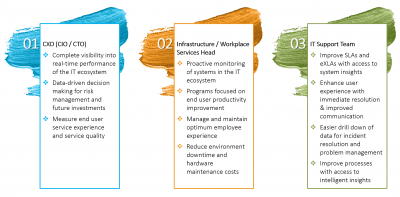
Has it ever happened to you that while working on a super critical deliverable on your laptop/desktop, the application freezes or the OS behaves abnormally, nothing works except the clock that keeps ticking? You try hitting all the keys on the keyboard, but to no avail, and you are forced to press and hold the power button for a manual restart. And once you are back, sometimes all or most of the data is lost! Such incidents are super frustrating for digital workers and negatively impacts user productivity, mission-critical deadlines, and leads to poor IT perception.
In today’s digital landscape, organizations rely on intelligent technologies to automate tasks, streamline processes, and adapt new ways of working. Such technologies are adapted with end-user experience focus to make their life easy. What many organizations fail to prioritize is maintaining the optimal health of the IT assets and proactively keep the systems in order. Modern IT assets are being designed keeping in mind the need for uninterrupted high uptime. To address this, organizations invest more in IT teams for faster issues/problem resolution. But, irrespective of how good the support is, end users are bound to face system downtime, application, or OS malfunction that leads to productivity and data losses. This is where proactive device monitoring and performance management becomes crucial and hence new-age technologies like “self-healing” make the real difference.
The Self-healing Definition: If we were to define “self-healing” from a layman perspective, it is a platform that maintains the system performance at the optimal level by taking proactive measures to fix anomalies at source, notifying the users for assisted service and even the IT team for preventive maintenance. Self-healing platforms essentially help in proactive performance monitoring of the devices and resolve hidden issues at the source. They also empower users with automated self-help, i.e. without waiting for them to encounter issues, the platform can resolve issues on its own, otherwise the same can be quickly routed to the IT team for resolution. A self-healing platform helps the end-users and IT teams primarily in three areas:
- Device Self-healing to continuously maintain the desired state of computing, which can be accomplished through fully automated real-time issue resolution at the source, powered by simple scripts or sophisticated bots. It can be anything within the device ecosystem from an application to OS to network etc.
- User Empowerment by helping them with proactive issue detection and timely notifications with guided actions that allows maintaining expected device performance. It empowers the end-users with assisted self-help, enhancing their experience and remediates issues at initial levels
- Proactive Device Monitoring for problem prediction and automatic trigger of the remediation process to ensure endpoints are continuously maintained at the desired levels. This also helps the IT teams with device ecosystem monitoring, discovery, and response and resolution mechanism
These capabilities have various pre-defined steps and procedures that prevent/recover the device from the expected failure state. Self-healing platforms help to reduce issues/incidents by up to 25%-30%, thus improving the end-user productivity and dramatically reducing the operational costs. With a strong integration with the ITSM platform, it provides clear visibility of all the devices to the IT teams. Moreover, self-healing platforms also help in detecting non-compliant and unusual activities across endpoints, which provides the IT teams the ability to make data-backed decisions.
Experience Baselining: A self-healing platform not just stops at proactive monitoring and issues repairs; it creates visibility on the real end-user experience and helps to understand what needs to be done to improve it. To achieve this, it starts at the very core of experience baselining for all the users in an organization. This baselining allows the IT team to make targeted decisions that would gradually impact and improve the end-user experience. On an on-going basis, with IT initiatives coming into the play for end users, they are prompted with targeted questions to measure their experience across IT performance. The gathered data is transformed into actionable insights to drive end-user experience improvement initiatives.
Running on Automation: There could be multiple channels for automated resolution of potential issues in a “Digital Workplace”. A self-healing platform follows a data-driven approach for measuring, delivering, and improving user journeys and the daily experience of users through the insights on employee experience, based on collected data and actual feedback. Potential issues that could cause major problems in the day-to-day work of a digital worker are automatically identified and resolved. This leads to –
- IT wins – When the IT team proactively identifies endpoint problems through analytical dashboards and automatically remediates them without user interference
- More power to the user – When the user takes guided steps to resolve issues on their own
- Quieter Service Desks – With the above two, remediation at the source means less service desk tickets and for those that do get placed, it often means quicker resolution
Transparent Governance: Here is how a self-healing platform can help various personas in an organization to continuously measure the health of the ecosystem from the user, application, and device standpoints.

Final Thoughts: As digital enterprises make move towards adopting “self-healing” platforms, it not only helps the IT teams to be more proactive and efficient but also helps them follow a unique issue resolution approach from the point of view of the end-user. With such a “user-centric” approach, where end-users care about the fast and reliable applications and devices, the IT Teams focus is shifting to direct feedback from the end-users for experience measurement across their devices. This is not just helping the IT teams to “be informed”, but also to “be aware” of the performance of all endpoints in the ecosystem.
About the author:

Kapil Wasnik – Lead Consultant, ITC Infotech
In his current role, as one of the solution leads to ITC Infotech’s Digital Workplace services, Kapil interacts with global customers to understand and address business, IT, and end-user challenges. He has been with ITC Infotech for about three years now. Kapil focuses on technologies that can enhance the end-user experience, improve productivity, and result in cost takeout.
The post How End-user Computing (EUC) Self-Healing Boosts User Productivity appeared first on NASSCOM Community |The Official Community of Indian IT Industry.







